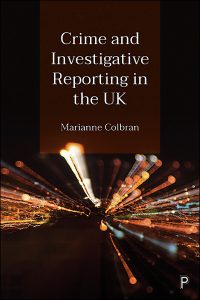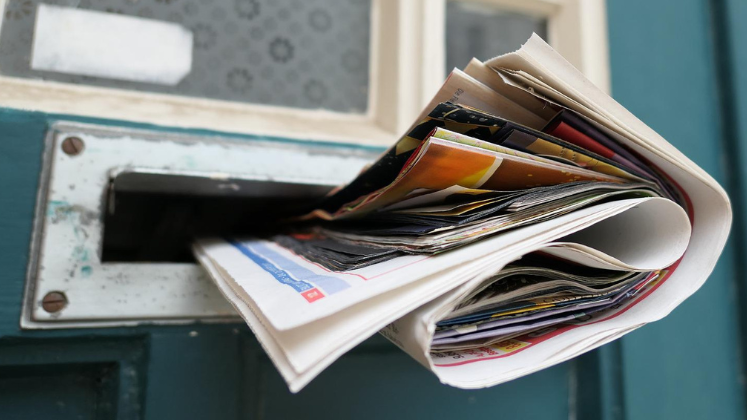We speak to Dr Marianne Colbran about her new book, Crime and Investigative Reporting in the UK, which offers an ethnographic study of UK crime news reporting over the last 40 years, covering the breakdown of relations between the Met and the mainstream media, the fallout from the 2011 phone-hacking scandal and the rise of non-profits that have the potential to repair crime journalism by reporting with – rather than on – marginalised communities.
Q&A with Dr Marianne Colbran on Crime and Investigative Reporting in the UK. Policy Press. 2022.
 Q: Before becoming an academic, you were a television scriptwriter, writing for shows including The Bill. How did that experience inform your research?
Q: Before becoming an academic, you were a television scriptwriter, writing for shows including The Bill. How did that experience inform your research?
When I worked for The Bill in the 1990s, our stories had to be based on research and observation of police work, so we were expected to spend time shadowing police at all levels. I visited domestic violence units, went on the streets with community liaison officers, went out in panda cars and spent time at the police training college in Hendon. It was invaluable grounding for me to see police work up close and realise that, most of the time, the police were essentially providing another social service.
But it also helped me in another way – when I started my MSc in Criminology at LSE in the 2000s, I was fascinated by how much research there was on the content of crime fiction and crime news. But there was little research on how production processes shaped the content of both. That was something I knew all about as a writer – how the story you started out writing often became something very different by the end, and how constraints, such as budgets or times you could film or the ideological values of the executive producer, played a part in what stories you could or couldn’t tell. I was able to take that knowledge and bring it to bear on my academic work on crime drama and, in my new book, on crime news.
Q: Your new book offers the first ethnographic study of crime news reporting in the UK in over 25 years. Why is now such an apt time for this research?
Firstly, this research is timely given how much the Met has been in the news recently – the murder of Sarah Everard, the taking of selfies by two Met officers with the murdered bodies of two Black women, sisters Bibaa Henry and Nicole Smallman, and, more recently, the lack of transparency over the ‘Partygate’ investigations. Over the last ten years, relations have broken down significantly between the Met and the national press. With the advent of social media, the Met are increasingly able to bypass the press and are less accountable than ever before. I think that’s something we should all be concerned about.
Secondly, over the last two years, the content of crime news journalism has come under increasing scrutiny. Following the murder of George Floyd in May 2020, there were calls to ‘defund the police’ – but also to ‘defund the crime beat’. I attended quite a few online conferences where journalists and members of the public argued that crime journalism was racist, sexist, classist and promoted harmful stereotyping of Black, Brown and other marginalised communities. People are becoming aware of the problems of traditional crime reporting. However, they might not know of the work that investigative non-profits are doing to redress these representational harms. This gives real cause for optimism about the future of journalism in this country.
Q: Why is it vital to examine the relationship between the press and the police?
Long before the ‘defund the crime beat’ movement, media criminologists raised concerns about its negative and harmful portrayals of people of colour and marginalised communities. They argued that it concentrates on sensationalist and violent crimes, while under-reporting crimes of ‘social harm’, such as accidents at work, crimes of the environment or abuses of human rights. But there’s very little research into how these representations come into being through the production processes of crime news. It’s important to understand the organisations in which these stories are created, the working practices and norms that affect what can be reported and, crucially, the relationships journalists have with their sources. In the case of my book, these are the relationships between crime journalists on national newspapers and senior officers and press officers from the Met.

Image Credit: Contrast version of ‘Police Line Do Not Cross’ by Tony Webster licensed under CC BY SA 2.0
Q: You look at how these relationships have changed between the 1980s and the present day. What are some of the key shifts in this 40-year period?
Although classic criminological texts from the beginning of this era (Steve Chibnall, 1977; Stuart Hall et al, 1978) suggested the police had the upper hand, my interviewees – senior police and press officers in post at the time – saw things differently. They argued that the press had powerful resources – the power to quote interviewees out of context, the power of the last word and the power to deny access. But press officers also talked about the importance of promoting an image of transparency and accountability. They discussed how it was important to own up to mistakes when the Met had mishandled investigations and to take journalists out with them to preclude any inaccurate or prejudiced reporting.
The relationship between police and press became more complex during the 2000s. This was partly due to the rise of the Rupert Murdoch-owned press, including papers such as The Times, The Sun and the now defunct News of the World, and their power seemingly to make or break the reputations of senior police officers. A number of my interviewees noted there was overt favouritism on the part of certain press officers toward Murdoch journalists, with ‘scoops’ given to them on a regular basis.
However, I would say the real shift in power came in 2011, due to two factors: the recommendations of the Leveson and Filkin Reports, following the phone-hacking scandal, combined with the widespread uptake of social media by the Met and other forces following the nationwide riots in August 2011.
Q: What impact did the phone-hacking scandal have on the relationship between crime reporters and the Met?
The first shift came after the publication of the 2012 Filkin Report. This recommended the recording of all contact between the police and the press, but the Met went further and clamped down on official and unofficial contact. A number of journalists told me they were no longer being given routine crime stories. They also told me they had received calls from Scotland Yard asking them to supply a list of their official and unofficial police contacts, but all had refused, seeing this as a betrayal of their sources. In the past, many stories of police corruption and abuse of police power had come from within the Met itself. Journalists feared that channel was now permanently closed to them.
A number of senior police officers and one former press officer I interviewed also had a similarly negative view of the clampdown on contact. Senior officers commented that off-the-record meetings with the press had been very useful when they were working on particularly sensitive investigations where early disclosure of information might cause harm. Press officers suggested the clampdown had made their life harder: given colleagues had been arrested for having a coffee with a press contact, using discretion to decide what could be given to a journalist was a luxury they could no longer afford. They worried that the breakdown in communications would seriously damage police and media relations in the long term – and that seems to be the case several years on.
Q: How has social media changed the dynamics of crime investigative reporting?
Three key objectives inform the Met’s relationship with the press: promoting their public image; management of risk; and increasing trust. Social media has helped the Met to pursue these aims more effectively. Firstly, social media allows the Met to publish stories of police valour or success, which the traditional press might overlook. Secondly, they can communicate risk directly to citizens. Thirdly, social media is used to humanise the police through humorous posts and webchats. While this allows the police to communicate more directly with the public, they can also bypass mainstream media. Crime reporters have suggested that while incidents are being reported on the Met’s Twitter feed and news website, journalists are not being given background information or access to officers making the tweets. As a result, crimes are going unreported in the mainstream press.
Social media also allows the public and press to monitor the police. In the past, if citizens recorded footage of police brutality, they had to hand it to a newspaper to stand a chance of others seeing the video. Now they can upload such images in real time and pre-empt any police counter-narrative. The murder of George Floyd is a case in point. But the public’s ability to hold the police to account is limited. Bystander footage of police brutality can be dismissed as a partial representation. Internal investigations of police brutality are often subject to non-disclosure agreements, and it can take years for cases to reach a ‘serious’ enough threshold to be investigated in the first place. All in all, the police has never been less accountable in many ways, nor have traditional crime journalists been so hamstrung in their efforts to fulfil their Fourth Estate role.

Image by DieElchin from Pixabay
Q: You quote a finding from a Diversity in Journalism report that 8 per cent of journalists come from non-white ethnic groups, compared to 12 per cent in the overall British workforce. How has this lack of diversity in newsrooms affected crime reporting?
Research suggests that lack of diversity in newsrooms means there is often a disconnect between journalists and their audiences: the majority of reporters are white, male and often from privileged backgrounds. They may not have many friends or contacts among Black or other marginalised communities. That means that stories that are important to those communities may be missed by predominantly white newsrooms, because journalists will not know these are important issues to them.
The closure of many local news outlets has also meant there are weakened links between communities and the media, so journalists are often ‘parachuted in’ at moments of crisis. Through not knowing the communities they are reporting on, journalists often report in the same negative ways, perpetuating their marginalisation. In addition, certain journalism ‘norms’ often preclude the inclusion of Black and other voices: in particular, the practice of relying on ‘experts’, such as the police or the judiciary – voices that are historically predominantly white.
Q: How is the rebirth of investigative journalism through non-profits helping to redress the representational harm historically done to marginalised communities?
I focus on the work of two non-profits, The Bristol Cable and The Bureau for Investigative Journalism, together with the latter’s sister project, the Bureau Local. They are called non-profits as their work is funded by philanthropic grants and reader donor funding, which allows them to practise what they call ‘slow journalism’, concentrating on stories they believe are important. What’s so exciting is that although these non-profits are not setting out expressly to report on crime, they are showing there are new ways of reporting on Black, Brown and other communities that are often represented negatively in the press and giving these communities a voice.
One way is by reporting with under-represented communities, rather than on them. An example is The Bristol Cable’s ongoing coverage of Gypsy, Roma and Traveller communities. They set out to redress negative coverage by reporting on the positives these communities bring to Bristol, including donations to food banks. But they are also careful to give Travellers the chance to tell their stories. The Gypsies and Travellers Communities Bill proposed turning Traveller sites into land for housing and moving all Gypsies and Travellers into houses ‘to help them integrate’. The Cable explored the impact of the Bill on Travellers’ lives, drawing from interviews with members of the community. By contrast, a Daily Mail report, outlining proposals by the Home Secretary to enable police to remove ‘unwelcome visitors’, did not include any interviews with Travellers.
Q: How might these non-profits change our fundamental understanding of crime?
Traditionally, mainstream crime reporting has focused on crime as an event rather than the underlying causes. Non-profits are changing our fundamental understanding of crime in two crucial ways. First, by moving away from reporting on crime as a one-off to reporting on what they term ‘systemic wrongs’ (what media criminologists might call ‘crimes of social harm’), they are expanding the scope of crime reporting. Second, they are able to bring a discussion of causes and effects into the conversation.
An example is the Bureau Local’s ‘Dying Homeless’ project, prompted by the death of a homeless man outside the Houses of Parliament. The Bureau decided to investigate how many people were dying homeless and learned that no one was collecting that data. The Bureau travelled across the UK, visiting soup kitchens and homeless shelters, talking to homeless people and co-creating reporting with them. By understanding the personal stories behind the statistics, the Bureau Local could discuss some of the causes of these individual tragedies – cuts to mental health provision, drug and alcohol services and a benefit cap. It’s a move towards what some scholars term ‘accountability journalism’ – exploring a social issue to see what does or doesn’t work and what should change. It’s a move from stories focusing on ‘who’s to blame’ – a key part of traditional crime reporting – to focusing on ‘what can we do’.
Q: You state that in 2017, you advocated a return to a relationship of trust and reciprocity between the press and the Met, but you now see this recommendation as ‘too simplistic’. What led you to a different conclusion today?
I don’t think returning to former relations would be desirable for the Met or for legacy media journalists. The relationship was seriously flawed. Over the last two years, a general perception has arisen that the Met’s dominant culture is one of secrecy and defensiveness in which reprehensible behaviour is allowed to carry on. A prime example was the selfies taken by two Met officers beside the dead bodies of Bibaa Henry and Nicole Smallman, shared with no fewer than 40 other officers on WhatsApp. On the face of it, that suggests that most of those 40 officers either condoned this behaviour or felt unable to make a stand against it. I believe that’s a culture that needs to change. Such changes in culture are not easy, and they don’t happen by accident, but they can nevertheless be achieved. I believe the Met comms team in turn should move from an apparent ‘spin doctor’ approach to give a more balanced and honest reflection of the organisation.
But I also think legacy media need to learn from the events of the last few years and to take on board the criticisms of the ‘defund the crime beat’ movement – to be more critical of the systems they are operating within, looking carefully at the breadth of experts they are using and whose voices are being left out. It’s not a question of going back to the old days, but more a time for reflection – and in the case of legacy media, learning from the non-profits that stories can be told in different ways that are less harmful for marginalised communities.
Note: This interview gives the views of the author, and not the position of the LSE Review of Books blog, or of the London School of Economics and Political Science. The interview was conducted by Dr Rosemary Deller, Managing Editor of the LSE Review of Books blog.







